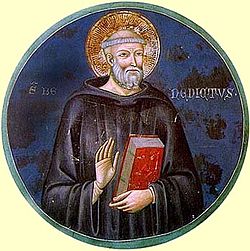Witiza, the son of Count Aigulf of Maguelonne, a Visigoth, was born around the year 747. As a boy, Witiza was sent to the court of the Frankish king, Pepin, for education and training as a courtier. The boy did well at court, serving as cup-bearer to Pepin and his son, Charlemagne and participating in military action. In 773, while on campaign in Italy with Charlemagne, Witiza nearly drowned while rescuing his brother from the Ticino River. Such a dramatic event became a turning point in the life of the young man.
Leaving the service of the Emperor, Witiza entered the monastery of St. Sequanus (Saint-Seine) near Dijon and embarked on an extremely zealous effort at acetic living. He went about barefoot, slept on the ground, and ate nothing but bread and water. Here he took the name Benedict and made that saintly monastic his spiritual patron.
In 779, the monk Benedict returned to family land on the Aniane River with the intention of being a hermit. Soon several others joined him and the Aniane Monastery was established. Perhaps Benedict’s extreme practices were too much, for the community did not last long. In 782, he re-founded the monastery, this time following the Rule of his patron saint. As this community grew, Benedict founded other monasteries and was eventually considered the abbot of most of the monasteries in Charlemagne’s empire.
Before this time, the Frankish monasteries (like their English counterparts) had suffered greatly during the Viking invasions and had lost much of their former discipline. They had also often been “owned” by the laymen who had provided land for their foundation. Benedict took it upon himself to reform the monasteries, and he was aided in his efforts by Louis the Pious, who had succeeded his father as emperor in 814.
Using the Rule of St. Benedict as his guide, Abbot Benedict made prayer, study, and manual labor a part of every monk’s day. This orderly pattern of life soon resulted in stronger, more disciplined monasteries – the “powerhouses of prayer” which was (and is) so needed by the rest of the Church.
The heresy of “adoptionism” – which said that Christ was a man only adopted by God as his son – was proposed by a bishop, Abbot Benedict opposed it vigorously in his writings and assisted at the 794 Synod of Frankfurt where it was condemned. He headed a council of abbots at a Synod of Aachen in 817, who compiled new rules for monasteries. Once again, based on the Rule of St. Benedict, these regulations required a full liturgical life with the celebration of daily Mass and Divine Office; they stressed poverty and chastity for each monk; and they gave special emphasis on teaching and the copying of manuscripts.
St. Benedict died on February 11, 821, after nearly fifty years of serving God as a monastic. We give thanks to God for the work of St. Benedict and we ask for his intercessions that we, too, may lead orderly, prayerful lives.
